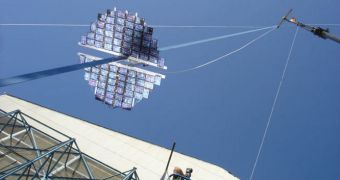The idea of a space elevator started being popularized in the 1970s, although, at the time, it was looked at as being something next to impossible. Since then, advancements in modern technologies have brought this goal within reach. Of the hypothetical elements that would go into such a device, only the actual cable needs to be further developed. The most likely design will be based on carbon nanotubes, and scientists have yet to find a way of growing them to the needed length. As for the device that will constitute the actual elevator, NASA is holding a challenge, to get a view of the best designs.
There are, of course, numerous approaches to constructing a space platform, but the thing that unites all designs must be their ability to, in essence, climb on a wire. They can differ from thereon, but it's essential that they have the ability to handle the slipping and huge torque required to climb a wire all the way up to the low-Earth orbit. The Space Elevator Games are therefore set up in such a way that they do not hinder innovation. In other words, participant teams only have a couple of limitations, including a minimum-allowed speed. The robots that do not achieve it are automatically disqualified.
This year's Games had a $2-million prize, the American space agency announced at the beginning of the competition. This Wednesday, a team from Washington state, called LaserMotive, managed to climb a cable that was about 3,000 feet (900 meters) long. The tether was suspended to a hovering helicopter, and the team's robot climbed it at an average speed of eight miles per hour (13 kilometers per hour). While this was the best feat thus far obtained in the competition, it's far from the performances that would be required of a real scale elevator, in the sense that proponents first envisioned it, Space reports.
Another requirement of the Power Beaming Challenge is for the teams to power up their vehicles using a remote source. The power needs to be beamed upwards to their craft, which need to convert it to mechanical force, and then move upwards. The contest is being held in the California desert, inside the Edwards Air Force Base, where the NASA Dryden Flight Research Center is located. If a space elevator would ever be built, its wire would stretch for about 22,000 miles (35,000 kilometers), and would require a very powerful climbing structure to overcome the force of gravity.

 14 DAY TRIAL //
14 DAY TRIAL //